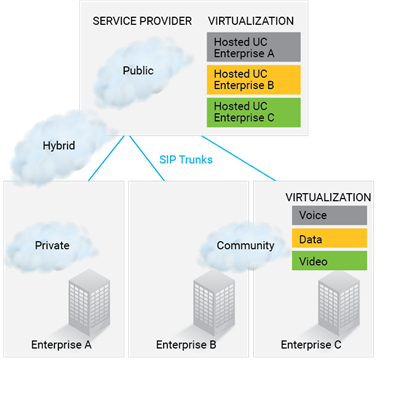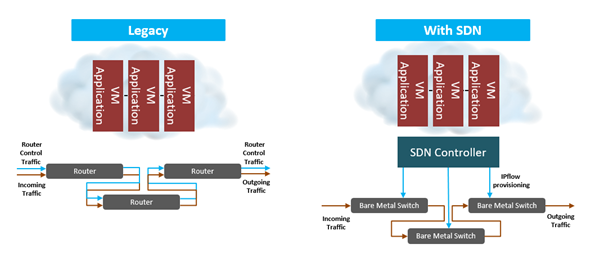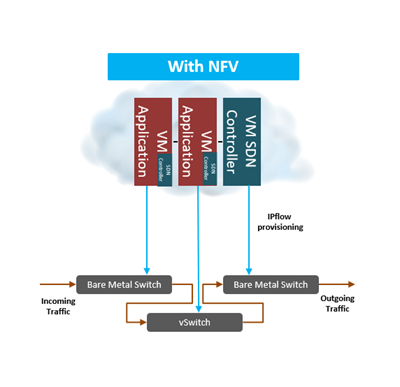What is NFV?
Network function virtualization (NFV) is envisioned as a savior for telecom network operators and service providers that boosts economics, innovation and agility needed to address explosive traffic growth in their networks with reduced capital and operating expenditure. It will bring significant change to the way services are developed, tested, and deployed faster than ever before.
So what is NFV? Is it the same as cloud computing? How is it related to software defined networking (SDN)?
These are all questions you've probably heard or even asked yourself. Let me explain in this post the answers to these basics questions.
What is cloud computing?
Often referred to as "the cloud", it is the delivery of on-demand resources, everything from hardware to software applications, over the internet on a pay-for-use basis. It consolidates hardware infrastructure (standard high-volume servers, networking, switches and storage), software platform (everything required to build and deliver web-based applications/services), and software services (hosted by web service providers that connect to their end customers) in data centers; that is managed and orchestrated using proprietary software or open source such as OpenStack and CloudStack.

The business initiators of cloud are commercial web service providers and enterprises and that many have successfully built billion dollar businesses enabling infrastructure-as-a-service (IaaS) (e.g., Amazon), platform-as-a-service (PaaS) (e.g., Google) and software-as-a-service (SaaS) (e.g., SalesForce) in public or private or community or hybrid cloud as end customers’ security requirements demands.
Let us take a quick break to refresh fundamentals learned as students: the Open System Interconnection (OSI) model. It defines a networking framework to implement protocols in seven layers:
- Physical
- Data Link
- Network
- Transport
- Session
- Presentation
- Application Layer
Various equipment/devices (software and hardware) are used within the data centers that connects servers and storage, as well as different data centers. Some of these equipment supports all seven layers (e.g., web server (1-7)); or only part of the seven layers (e.g., router (1-3), switch (1-2) and optical cable (1)) that are capable of interoperating with standard protocols to deliver IaaS, PaaS and SaaS services to the customers.

On a practical note, most of the web service/application (1-7) are now deployed in the cloud as software-only devices on the industry standard commercial off-the-shelf (COTS) servers.
What is software-defined networking (SDN)?
Initiated by Enterprise IT, born on college campus, and matured in data centers, SDN replaces expensive closed and proprietary firmware based 1-3 network layer devices that supports both network control and data traffic forwarding (e.g., router).
How is it replaced using SDN?
It is achieved by software-based control (programmable network through software abstraction—SDN controller) using globally aware open protocols such as OpenFlow to provision, control and forward data traffic through less expensive bare metal switch (or virtual switches) devices within and between data centers. By adopting cloud and SDN, many enterprises IT and web service providers have been successfully enjoying boosted economics, faster innovation, and agility.
What is NFV?
Initiated and lead by telecom network operators and service providers, NFV, the savior for telecom business, aims to transform the telecom industry to perform similar to the web and enterprise IT. Unlike web and enterprise network, today’s telecom network comprises of an expensive, large and increasing variety of dedicated proprietary hardware to deliver telecom services (VoLTE, ViLTE etc.).

NFV is the concept of replacing these dedicated proprietary hardware—such as firewall and session border controller (SBC)—with software running on commercial off-the-shelf servers (same as web servers in the cloud), which could be located in data centers, network nodes and in the end-user premises. NFV has an option (not mandatory) to enjoy greater benefit integrating SDN in the telecom applications (within or with external SDN controller) to control network resources for telecom data traffic forwarding.
Is NFV the same as cloud for telecom networks and services?
As explained above, most of it (concept, technologies, benefits, etc.) are similar but not the same. The fundamental requirement of carrier-grade telecom infrastructure is different than that of enterprise IT and web platforms. The management, security, quality, performance, availability, reliability and scalability requirements are different and stringent (5 nine's) in telecom networks.
These requirements are challenging and in many cases not possible to achieve in the existing cloud infrastructure. For example, fault deduction is expected within sub-second not in minutes. The European Telecommunications Standards Institute (ETSI), working together with leading telecom companies, opensource communities and other standard organizations (SDO), has defined and continues to define and address these challenges by defining architecture, interfaces, PoC and all that apply.
In conclusion, as the innovation cycles and traffic in the network continue to accelerate, telecom service providers and network operators have to find ways to boost economics, innovation and agility needed to fully automate network and services. NFV is the savior and that SDN is complementary for the benefits of software-defined networking to be fully realized.




